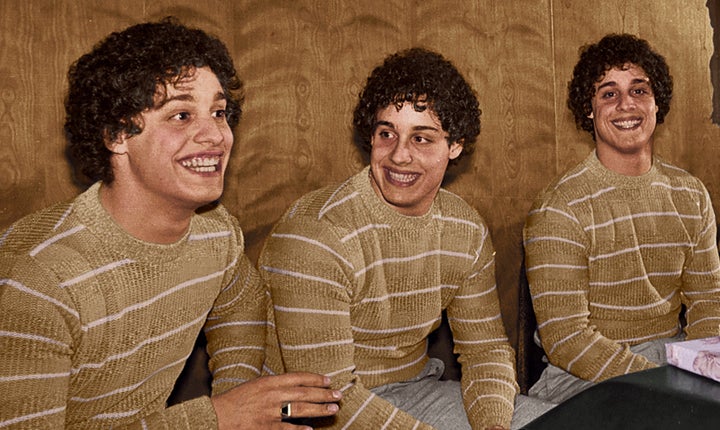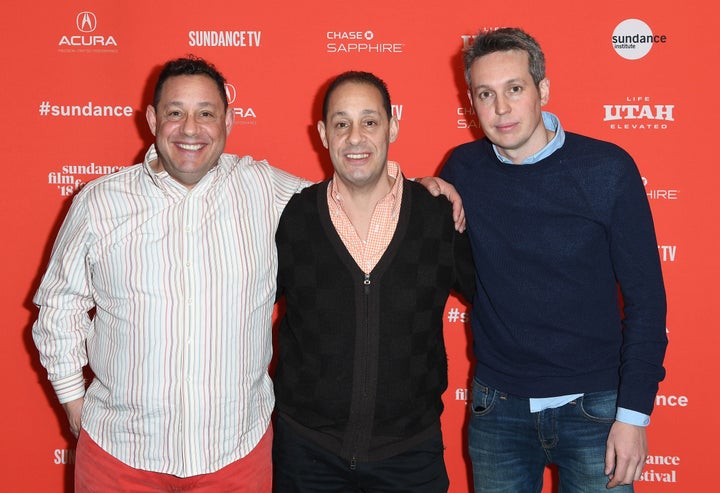
Editor’s note: “Three Identical Strangers” is best experienced without any prior knowledge of its subjects’ story. But the documentary chronicles a nearly 40-year-old media phenomenon, so we’re going to discuss it in detail. If you want to avoid “spoilers,” you should see the film before reading this.
About 20 minutes into “Three Identical Strangers,” you might ask yourself where this documentary could possibly be headed. Shocked by the saga’s immediate crescendo, you’ll ask yourself the same question 20 minutes later, and again 20 minutes after that, and probably a few more times throughout the remainder of its 96-minute runtime.
There’s no soft build here. The movie opens in medias res, as pure happenstance reunites the titular 19-year-old identical triplets for the first time since they were separated at birth and adopted by three different families. Two of the brothers (Eddy Galland and Robert Shafran) connected after classmates mistook one for the other at a small New York community college that they both attended; the third (David Kellman) saw the news of their reunion in the New York Post, recognizing his own face twice over and subsequently tracking them down.
Born on Long Island in 1961, none knew the others existed until this seemingly blissful, life-altering discovery flowered in tandem with their nascent adulthood. “It was a miracle,” Kellman’s aunt by adoption tells the camera, recalling the first time all three were in the same room.
“Once we got together, there was a joy that I had never experienced in my life, and it lasted a really long time,” Shafran says.
Their reunion became a mini-phenomenon in the media throughout the 1980s, most notably with a “Phil Donahue Show” episode that juxtaposed the brothers’ uncanny alikeness ― similar interests, indistinguishable mannerisms ― with the fact that they were raised in different households and different cities. At its core, this was the perennial nature-versus-nurture debate, illuminated. Pulitzer-winning journalist Lawrence Wright revisited the matter as part of his 1999 book Twins: And What They Tell Us About Who We Are, by which point certain damning details about the triplets’ separation had emerged.

But, even with all the national attention, it wasn’t the full story. It wasn’t even the beginning. In fact, to this day, Tim Wardle, the British documentarian who directed “Three Identical Strangers,” is still wrestling with unanswered questions and shadowy enigmas about what really happened to the three brothers who’d unknowingly spent their childhoods apart.
Wardle came across this human-interest oddity about five years ago. His colleague Grace Hughes-Hallett had turned to Wright’s book for research while developing her own documentary about adoption. There, she learned the cursory details of the triplets’ estrangement: They were part of an experimental, unpublished study run by Peter Neubauer, a Freudian psychoanalyst who became a leading figure of child research in the 1950s and ’60s, right as psychology was proliferating in American academia. At the time, work that would today be deemed ethically dubious wasn’t uncommon; think of the Milgram obedience experiments or the Stanford prison experiment.
After other adoption agencies refused him, Neubauer partnered with the since-shuttered Louise Wise Services, an elite Jewish facility interested in exploring the behaviors of siblings separated at birth, to kickstart his study. In other words, according to the documentary, the organization effectively allowed Neubauer to turn the triplets into lab rats and conceal it for what would have been their entire lives.
“I’m not prone to hyperbole, but I was like, this is the single best story I’ve ever heard,” Wardle explained in an interview with HuffPost earlier this month.
By “best,” he also means the worst.
Right away, Wardle knew he had a movie on his hands. “To have even 50 or 60 percent of the story is easily enough for a film on its own,” he said. “Anything else was going to be a bonus.” But, in contacting the brothers and unearthing whatever details they could corral about the study, Wardle and his production team found themselves facing an increasingly cloudy quagmire.
Who exactly had bankrolled the shady enterprise? Wardle said the financial “spider web” was impossible to piece together entirely, but we know that Manhattan’s Child Development Center, which merged with the government-supported Jewish Board of Family and Children’s Services, was the primary benefactor. The National Institute of Mental Health contributed funds, as was reported in the ’90s.
How was the study conducted? Researchers from Louise Wise would visit the children’s respective homes once a week to administer tests and record video footage. The adoptive families were told this was part of a normal practice meant to observe the agency’s fostered clients. The brothers, too, have vague recollections of the house calls; as youngsters, they were uncertain of the visitations’ purpose.
Why hadn’t the boys’ adoptive parents been informed they were triplets? The agency, in coordination with the Child Development Center, decided its endeavor was ethical as long as the boys didn’t know one another existed. That meant the adults raising them couldn’t know either. But from the beginning, there were signs that something was awry. The babies would bang their heads against the walls of their cribs, for example, which Kellman attributes to “separation anxiety.”
How many siblings did Louise Wise separate in the name of research? Five pairs of twins, in addition to Galland, Shafran and Kellman.
Is everyone who was taken from his or her sibling now aware? No.
Is there any chance the study yielded fruitful commentary about nature versus nurture? Maybe. The children were placed in homes of varying economic stability, raised with contrasting parenting tactics and sensitivities.

Louise Wise Services sealed the contents of the study at the Yale University Library until 2066. That way, its subjects wouldn’t realize they’d become flesh-and-blood experiments. Accordingly, we can’t know whether it effectively proved that the fate of identical siblings raised in different environments would turn out to be, well, identical. We do know, however, that as soon as the brothers learned of their circumstances, their sunny reunion grayed. Mental-health concerns surfaced. In 1995, Galland killed himself.
Wardle, who had previously made vérité-style television docs in the United Kingdom, spent four years gaining the brothers’ trust and securing funding for a feature-length project that would chronicle the untold side of their story. But for every mystery he solved, another arose ― and they weren’t easy to decode. By now, few people involved with the experiment are still living, including Neubauer, whose reputation remained in good standing before his death in 2008.
The central lingering mystery concerns what appears to be multiple cover-up attempts exacted by the responsible agencies. For example, Wardle gleaned that three major television networks ― two in the ’80s, one in the ’90s ― tried to make documentaries about the brothers and the corresponding experiment. Wardle said he came across minutes from a Louise Wise meeting in which top brass insisted they would “shut down” these productions. “We have contacts there. We can kill this,” they apparently said of the networks.
Sure enough, all three networks nixed their specials before completion, including one apparently involving a Pulitzer-winning New York Times reporter, according to Wardle. He declined to identify the networks, as he was told “in confidence,” but at least one of the projects is public knowledge: A Newsday story from 1997 says “production started on a documentary about their lives, but it was never completed.”
That turn of events aligns with Wright’s summation of Louise Wise: It was run by “powerful people” from New York’s upper crust who were capable of steering the media off their trail, as they did by sealing the study’s results. After a protracted effort, the brothers have been granted access to a heavily redacted photocopy that Wardle said is “hard to make sense of.” It’s done little to ameliorate the emotional obstacles they’ve faced since ascertaining the truth behind their predicament.
Of course, Louise Wise isn’t the only entity that has raised suspicions. The Jewish Board apparently declined to participate in “Three Identical Strangers,” interacting with Wardle and his team only through a crisis-management PR firm. Since the film premiered to rave reactions at Sundance in January, Wardle said the brothers received a conciliatory letter from Jewish Board leaders indicating they “had the pleasure of watching your documentary” in the “comfort[s]” of their own homes.
How anyone from the organization received a private screener of “Strangers” remains unclear. Wardle said he didn’t even have a screener at the time.
When asked to comment on these specifics, a representative for the Jewish Board sent HuffPost the following statement: “We do not endorse the Neubauer study, and we deeply regret that it took place. We recognize the great courage of the individuals who participated in the film, and we are appreciative that this film has created an opportunity for a public discourse about the study.”
[Editor’s note: Since this story was published, a representative from HL Group, the PR agency that counts the Jewish Board as a client, contacted HuffPost to refute Wardle’s description of the letter sent to Shafran and Kellman. The Jewish Board did not, according to HL Group, write that its members screened the film at their homes. The representative declined to provide any further information.]
Meanwhile, a representative for CNN Films, which co-financed the movie with the UK’s Channel 4, declined to say whether the company gave anyone from the Jewish Board private access. Neon, which is distributing the film in theaters June 29, also declined to comment on the record. The National Institute of Mental Health did not respond to our request for comment.
Furthermore, throughout the process, Wardle said, he located a few folks with ties to the study who initially agreed to talk. But when his team contacted these individuals a second time, they would “never, ever respond again,” as if they’d been silenced.
Even if a dark cloud still loiters over the backstory, “Three Identical Strangers” proves a captivating watch, both as a portrait of people who never consented to being guinea pigs and as a fair-minded examination of research meant to yield groundbreaking revelations fundamental to the essence of family psychology. (Anyone who watched “Wild Wild Country” will see shades of Ma Anand Sheela in Natasha Josefowitz, Neubauer’s articulate research assistant who appears halfway into “Strangers” and unapologetically tries to justify the study’s intentions.)
Wardle said the two living brothers, who were paid for their life rights, were emotional the first time they saw the film, which manages not to sensationalize their story for the sake of drama. ”You delivered what you said you were going to deliver,” they apparently told the director. “They were very emotional about that. And I realized they’d been let down a lot in their lives.”
Since Sundance, filmmakers have pursued rights to the tale for a dramatic feature, as if this whole saga weren’t already stranger than fiction. Maybe others will be able to piece together the minutiae that Wardle and his team have not.
For now, he said, “it is still so opaque.”
